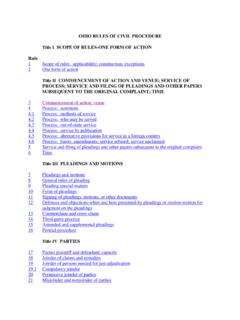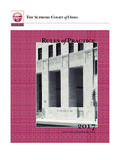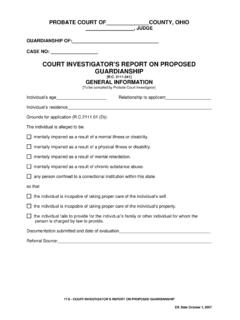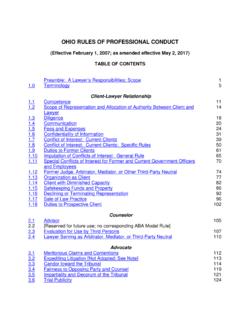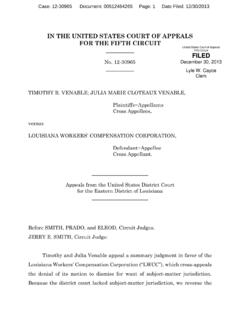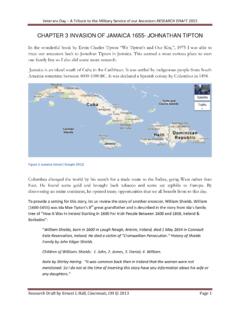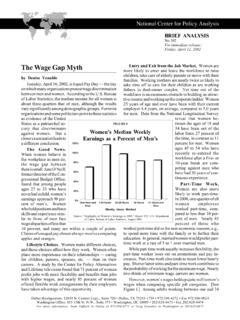Transcription of State v. Venable
1 [Cite as State v. Venable , 2010-Ohio-6211.]. IN THE COURT OF APPEALS OF MONTGOMERY COUNTY, OHIO. State OF OHIO : Plaintiff-Appellee : CASE NO. 24020. vs. : CASE NOS. 08CR4158. 10CR587. MARK Venable : (Criminal Appeal from Common Pleas Court). Defendant-Appellant : .. O P I N I O N. Rendered on the 17th day of December, 2010.. Mathias H. Heck, Jr., Pros. Attorney; Carley J. Ingram, Atty. Reg. , Box 972, Dayton, OH 45422. Attorneys for Plaintiff-Appellee Daniel R. Allnutt, Atty. Reg. , Box 234, Alpha, OH 45301. Attorney for Defendant-Appellant .. GRADY, J.: { 1} On or about March 12, 2009, the trial court granted Defendant, Mark Venable 's, motion for intervention in lieu of conviction, ILC, and stayed all criminal proceedings against Defendant in Case No. 2008CR04158 on charges of vandalism, (B)(1)(a), a fifth degree felony, and criminal damaging, 2. (A)(1), a second degree misdemeanor.
2 On March 8, 2010, a hearing was held at which Defendant acknowledged receipt of the notice of revocation of his ILC based upon multiple violations, including his commission of new criminal offenses. On March 16, 2010, pursuant to a plea agreement, Defendant entered a plea of guilty to obstructing official business, (A), a fifth degree felony, in Case No. 2010CR00587. The trial court then revoked Defendant's ILC in Case No. 2008CR04158, based upon Defendant's new felony offense, and Defendant's previously tendered guilty pleas to vandalism and criminal damaging in Case No. 2008CR04158 were filed. The trial court sentenced Defendant to concurrent nine month prison terms in both cases, 2008CR04158. and 2010CR0587. { 2} Defendant timely appealed to this court from the revocation of his ILC and his conviction and sentence. Defendant's appellate counsel filed an Anders brief, Anders v.
3 California (1967), 386 738, 87 1396, 19 493, stating that he could find no meritorious issues for appellate review. We notified Defendant of his appellate counsel's representations and afforded him sixty days to file his own pro se brief. No brief was filed by Defendant within that sixty day period. Accordingly, we deem this appeal submitted for decision on the merits, and the case is now before us for our independent review of the record. 3. Penson v. Ohio (1988), 488 75, 109 346, 102 300. { 3} Defendant's appellate counsel identified three possible issues for appeal. FIRST ASSIGNMENT OF ERROR. { 4} THE STATEMENT OF FACTS FROM THE BILL OF INFORMATION. WAS INSUFFICIENT TO SUPPORT THE GUILTY PLEA TO THE CHARGED OFFENSE.. { 5} Defendant was charged in Case No. 2010CR0587 by way of bill of information with obstructing official business in violation of (A). The bill of information was phrased in language { 6} identical to the statute, , and was clearly sufficient to charge an offense and provide Defendant with adequate notice of all of the essential elements of that offense.
4 7(B). At the March 16, 2010 hearing on the revocation of Defendant's ILC in Case No. 2008CR04158, Defendant entered a plea of guilty to the obstructing official business charge in Case No. 2010CR0587. When asked for a statement of the facts, the prosecutor read the bill of information into the record, and Defendant acknowledged that those were the facts to which he was pleading guilty. { 7} As a possible issue for appeal, Defendant argues that the facts contained in the bill of information were not legally 4. sufficient to support his guilty plea and conviction for obstructing official business. Defendant's guilty plea is a complete admission of his guilt, 11, that precludes challenging his conviction on the basis of insufficient evidence. State v. Buhrman (Sept. 12, 1997), Greene App. No. 96CA145; State v. Jamison, Montgomery App. No. 21165, 2006-Ohio-4933. This claim lacks arguable merit.
5 SECOND ASSIGNMENT OF ERROR. { 8} THE GUILTY PLEA OF THE APPELLANT WAS NOT KNOWINGLY, WILLINGLY OR VOLUNTARILY GIVEN.. { 9} As another possible issue for appeal, Defendant claims that his guilty plea to obstructing official business was not entered knowingly, intelligently, and voluntarily because he did not understand the effect of his plea or that he might be subject to post release control upon completion of his prison sentence. { 10} In State v. McGrady, Greene App. No. 2009CA60, 2010-Ohio-3243, at 11-13, this court stated: { 11} In order for a plea to be given knowingly and voluntarily, the trial court must follow the mandates of Crim. R. 11(C). If a defendant's guilty plea is not voluntary and knowing, it has been obtained in violation of due process and is void. Boykin v. Alabama (1969), 395 238, 243, 89 1709, 23 274. 5. { 12} A defendant who challenges his guilty plea on the basis that it was not knowingly, intelligently, and voluntarily made must show a prejudicial effect.
6 State v. Stewart (1977), 51 Ohio 86, 93; Crim. R. 52(A). The test is whether the plea would { 13} have been otherwise made. Id. at 108. { 14} A trial court must strictly comply with Crim. R. 11. as it pertains to the waiver of federal constitutional rights. These include the right to trial by jury, the right of confrontation, and the privilege against self-incrimination. Id. at 243-44. However, substantial compliance with Crim. R. 11(C). is sufficient when waiving non-constitutional rights. State v. Nero (1990), 56 Ohio 106, 108. The non-constitutional rights that a defendant must be informed of are the nature of the charges with an understanding of the law in relation to the facts, the maximum penalty, and that after entering a guilty plea or a no contest plea, the court may proceed to judgment and sentence. Crim. R. 11(C)(2)(a), (b); State v. Philpott, Cuyahoga App. No.
7 74392, citing McCarthy v. (1969), 394 459, 466, 89 1166, 22 418. Substantial compliance means that under the totality of the circumstances, the defendant subjectively understands the implications of his plea and the rights he is waiving. Nero, 56 Ohio at 108.. { 15} A review of the plea hearing refutes Defendant's claim 6. and demonstrates that the trial court, in accepting Defendant's plea, meticulously complied with all of the requirements in 11(C)(2), including informing Defendant about the effect of his plea, that his guilty plea is a complete admission of his guilt, and that upon accepting his plea the court would proceed with sentencing. The court also informed Defendant that following his release from prison he might be required to serve up to three years of post release control and the consequences for violating that post release control. { 16} When Defendant was later sentenced for the misdemeanor criminal damaging charge that was part of Case No.
8 2008CR04158, he expressed some confusion over the possibility that post release control could apply after he served his prison term on the felony counts. When the trial court offered to allow Defendant to consult with his counsel on that matter before proceeding with the plea agreement and sentencing, Defendant declined the offer and expressed a desire to continue. This claim lacks arguable merit. THIRD ASSIGNMENT OF ERROR. { 17} THE TRIAL COURT FAILED TO OBSERVE THE APPELLANT'S RIGHT. TO JAIL TIME CREDIT WHEN IT FAILED TO SPECIFICALLY ORDER ON THE. RECORD THE SPECIFIC NUMBER OF DAYS TO WHICH HE WAS ENTITLED.. { 18} At Defendant's request, appellate counsel raises an issue concerning whether the trial court properly calculated 7. Defendant's jail time credit and, specifically, whether any credit given included eight days spent in confinement on the vandalism charge in Case No.
9 2008CR04158. { 19} provides: { 20} The department of rehabilitation and correction shall reduce the stated prison term of a prisoner or, if the prisoner is serving a term for which there is parole eligibility, the minimum and maximum term or the parole eligibility date of the prisoner by the total number of days that the prisoner was confined for any reason arising out of the offense for which the prisoner was convicted and sentenced, including confinement in lieu of bail while awaiting trial, confinement for examination to determine the prisoner's competence to stand trial or sanity, and confinement while awaiting transportation to the place where the prisoner is to serve the prisoner's prison term.. { 21} In State v. Sears, Montgomery App. No. 20330, 2005-Ohio-1593, at 5-6,we stated: { 22} We have previously addressed the nature of the trial court's obligation with respect to the calculation of jail time credit.
10 { 23} Formerly, trial courts were required by to recite, in the termination entry, the amount of time that a convicted defendant spent incarcerated before sentencing. 8. However, was amended, effective July 1, 1998, and no longer contains this requirement. The Department of Rehabilitation and Corrections [sic] understandably would appreciate a trial court's recitation, in its termination entry, of the amount of time that a convicted defendant has spent in jail upon a charge for which he was convicted, so that the Department may perform its duty pursuant to * * * Although we cannot say that a trial court is required by law to recite the amount of pre-sentence jail time in its termination entry, that is, in our view, clearly the better practice. State v. Reichelderfer (Apr. 30, 1999), Montgomery App No. 17445. { 24} The termination entry to which we referred in Sears is, in fact, the judgment of conviction journalized by the court following imposition of sentence.

